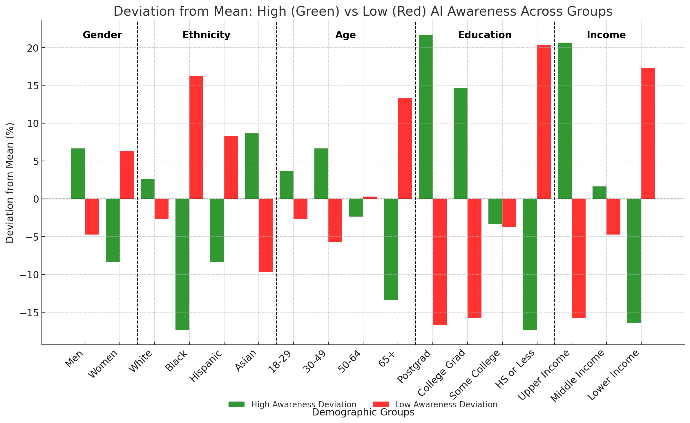
AI continues to embed itself into the fabric of business. However, the conversation often neglects a key component in the shadows: people. Training people in prompt engineering and system integrations is not enough.
Today’s “AI experts” are too focused on the technology and process sides of the “People, Process and Technology” paradigm. They assume that improving technology will create business value and optimizing processes will ensure consistency. However, this view is flawed because it overlooks the crucial role of the people who use these systems.
Too often, “experts” advocate silos of competencies. This creates unnecessary and negative organizational impacts.
My message in this article is clear: AI adoption is a critical strategy that must be directed at an organizational level and managed by leaders clearly and cogently.
Why humans matter in the AI ecosystem
No matter how advanced, technology needs human insight to succeed. When organizations focus too little on people, they create systems that don’t match employees’ needs and skills. This misalignment can lead to:
- Resistance from your teams.
- Inequality of job opportunities.
- Decreased morale.
- Ultimately, the underperformance of AI initiatives.
A fundamental shift toward prioritizing people and their competencies is critical.
Soft skills are necessary to deliver equal opportunity
Pew Research Center surveyed more than 11,000 U.S. adults about their use of AI, excitement for the technology and knowledge of where AI is used. The findings show that AI awareness varies widely across gender, ethnicity, age, education and income levels.

There’s a lot of information in the chart, but the key takeaway is that AI awareness is highly skewed based on gender and ethnicity:
- Men are much more likely to have a greater high awareness, and women have a greater low awareness.
- African American and Hispanic people are more likely to have a low high awareness and a high low awareness.
The message is clear: Organizational leaders must take a proactive role in thoughtfully guiding AI adoption. They must ensure that the soft skills of all team members are considered to prevent inequality in job opportunities.
Dig deeper: Why brands must bridge the knowledge gap in AI adoption
Non-technical functions will drive the most value from AI
Despite what some may think, AI’s success isn’t solely in the hands of technical experts. McKinsey highlights that a remarkable 75% of AI’s value will be realized across five business functions, three of which are non-technical: customer operations, marketing and sales.
Go-to-market (GTM) teams play a key role in delivering value to their organizations. However, this doesn’t mean organizations should focus only on GTM AI strategy. They need a broader, organization-wide strategy with a GTM application.
Soft skills: The heart of AI adoption success
When planning an organization-wide AI program, considering soft skills is essential. These skills are key to successful change management and help teams adjust to AI. They’re the glue that holds technical innovations into a cohesive, functional reality.
Cognitive psychology shows how people interact with AI. Successful AI adoption requires fostering a growth mindset, encouraging curiosity and supporting the mental shifts needed to use AI effectively. When employees feel supported in these areas, organizations can have smoother transitions and greater engagement with AI.
Growth mindset
A growth mindset is the belief that skills and intelligence can be developed through dedication and hard work. This mindset is crucial in an AI-driven organization because it enables employees to view challenges as development opportunities rather than obstacles. Encouraging a growth mindset leads to higher productivity and engagement, as employees are more likely to take initiative, embrace innovative technologies and continuously improve their skills.
About 17% of workers who are more concerned about AI today than last year say they personally know someone whose job was replaced by AI, according to EY. Understanding and cultivating a growth mindset fosters an environment where learning and adaptability become integral to business success.
Employee confidence and resilience
Confidence and resilience involve equipping employees with the ability to adapt and make informed decisions despite uncertainty. In an AI-forward organization, where rapid technological changes are the norm, the capacity to handle ambiguity without undue stress is critical. Up to 75% of employees are concerned AI will make certain jobs obsolete, with many (65%) saying they are anxious about AI replacing their jobs. By building confidence and resilience, organizations ensure that employees remain productive, engaged and capable of navigating challenges while reducing anxiety and creating a more stable and positive work environment.
Dig deeper: A people-friendly approach to adopting AI in marketing
Cognitive flexibility, agility and growth
Cognitive flexibility refers to the ability to adapt thinking and approach based on new information and changing circumstances. This skill is vital in an AI-rich environment, where the agility to shift strategies and embrace novel ideas enhances personal and organizational growth.
By fostering cognitive flexibility, organizations enable employees to innovate and respond proactively to AI-driven insights, making informed decisions that propel business success.
Accountable and responsible decision-making
This competency involves creating frameworks where decisions are made with careful consideration of ethical standards and organizational goals. In the context of AI, responsible decision-making ensures that technology is used wisely and transparently, fostering trust and accountability.
Today, two issues top the list of employee concerns: the quality of AI outputs and the speed at which AI is being adopted. Understanding this process is key for employees to manage AI tools effectively and ethically, ensuring that AI-driven decisions align with broader business values and contribute positively to organizational objectives.
Collaboration skills
Effective collaboration is essential for integrating AI into workflows and harnessing its full potential. This skill entails fostering open communication, teamwork and cross-functional cooperation, bridging departmental silos to create a cohesive AI implementation strategy.
Collaborative skills enable employees to contribute diverse insights and foster innovation, driving collective productivity and ensuring that AI advancements are effectively leveraged across the organization.
Dig deeper: 5 ways to jump start AI adoption
Bringing everyone on the journey
AI adoption shouldn’t polarize a workforce into those who get it and those who don’t. Instead, create a culture of inclusion where every person in the organization feels a part of the transformation. It’s about ensuring everyone is on board, not by compelling them to learn coding languages, but by nurturing an environment where learning, adapting and collaborating across functions is encouraged and valued.
Embracing AI means investing in soft skills and mental readiness to ensure success. By aligning AI with human strengths, businesses can implement it effectively and build a workforce ready to thrive in an AI-driven world.
Dig deeper: integration/" target="_blank" rel="noopener">AI readiness checklist: 7 key steps to a successful integration
The post How to build AI strategies that prioritize people appeared first on MarTech.









